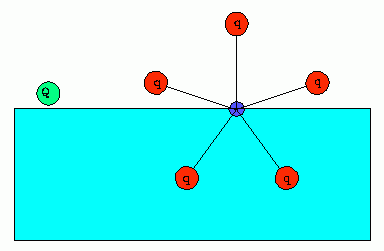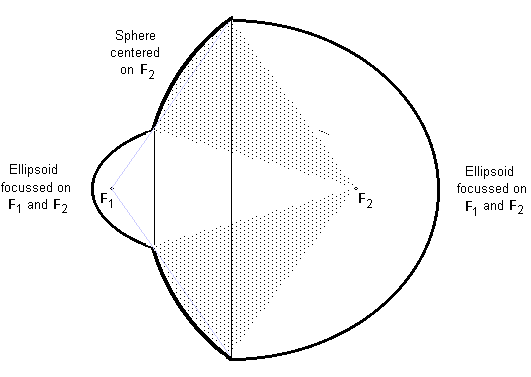
Advanced Concepts in Perpetual Motion Here are housed somewhat more innovative perpetual motion ideas, involving concepts of thermodynamics, quantum mechanics, field theory, and other areas of physics that are beyond those of the elementary introductory courses. Still, some of these may have very simple resolutions, once you get past the impressive-sounding distractions.
Dielectric-assisted charged wheel.
 |
A wheel has five arms, each with a charge of size q on its end. The wheel's axle is at the surface of a liquid dielectric (blue). The dielectric is our standard-issue zero-viscosity fluid that provides no impediment to the motion of the wheel and is also non-conducting. Its dielectric constant is K, and K > 1. To make the problem simpler, assume an infinite extent for the dielectric, like a huge ocean of it.
Another charge Q (green) is fastened at the left, just above the dielectric surface. The force between it and the upper charges is Qq/r2. The force between it and the lower charges (those immersed in the dielectric) is Qq/Kr2, where r is the distance between Q and each immersed charge, q. These forces are smaller than the forces between Q and the three upper charges on the wheel.
Clearly the net force is smaller on those charges in the dielectric than on those in air, and therefore the wheel should turn counter-clockwise if Q and q have the opposite sign, and clockwise if they have the same sign. But that won't happen. Why?
The Energy Sucker
Leigh Palmer shares with us his description and picture of an old PMM puzzle. Does anyone know the original source of this?
There will never be an energy crisis on earth. So long as energy is conserved, we will never run out. We need not even worry about losing it since the sun will replenish what leaks away. We must simply recycle the energy, reusing it as many times as we can. As is well known, however, this energy becomes less available with use, as is required by the second law of thermodynamics. What is needed, then, is a machine that can recondition our used energy so that it may be recycled. Such a machine, the energy sucker, is depicted in the diagram. It consists of an evacuated cavity which is lined with reflective interior surfaces having the geometry specified in the drawing.

The function of the energy sucker is to take two objects which are initially at the same temperature, for example two identical black rocks, and heat one while cooling the other. This is accomplished automatically in the energy sucker if the rocks are placed at the foci of the ellipsoids. We shall assume that there can be no transfer of heat to or from the rocks by conduction or convection. They interact with each other solely by radiation and absorption of electromagnetic energy. Consider the rock at F1. All of the energy which leaves this rock is reflected from one ellipsoid or the other, and thus is absorbed by the rock at F2. Most of the energy which is radiated by the rock at F2 strikes one of the ellipsoids and is subsequently absorbed by the rock at F1, but some of it (that part within the shaded solid angle) is reflected back to F2 by the spherical reflector. If the rocks are identical, and if they are initially at the same temperature, then they radiate with identical power. The rock at F1 radiates more than it absorbs, however, and the rock at F2 absorbs more than it radiates. Thus the rock at F1 will cool below its initial temperature, and the rock at F2 will warm up. The temperature rise will be small for the apparatus shown (it is left as an exercise for the reader to calculate it), but by cascading these suckers one can reach, in principle, arbitrarily high temperatures.
Both the hot and cold rocks produced by this process can be used to power heat engines, and they can be restored to useful temperatures in the sucker.
© 1987 by Leigh Hunt Palmer, who reminds readers that this apparatus is incapable of performing as claimed.
Here's Leigh's discussion and answer.
This old puzzle is sometimes called the "ellipsoid paradox in thermodynamics". Here's a recent journal article on this subject: Resolution of the ellipsoid paradox in thermodynamics. Theodore J. Yoder and Gregory S. Adkins. American Journal of Physics. 79, August 2011, p. 811.
Two perpetual machine puzzles.
Erann Gat sends us descriptions of two unworkable devices.
I really enjoyed your Museum of Unworkable Devices web page. Here are two more perpetual motion puzzles that you (and your readers) might enjoy.Now someone might object that as the electron speeds up on each pass through the electric field it will move in an orbit of increasing radius and miss the hole the next time around. That's a minor engineering detail, easily solvable by anyone who has worked with cyclotrons. Erann's solution is neat:1. Two perfect mirrors float in empty space. A laser beam bounces back and forth between them. Each time the beam reflects it imparts a recoil momentum on one of the mirrors. Because the mirrors are perfect, the beam never loses intensity and so continues to bounce back and forth forever, eventually accelerating the mirrors to arbitrary velocities.
2. This one may require some knowledge of field theory. Imagine two oppositely charged plates placed very close to each other. Some elementary analysis reveals that there is an electric field between the plates, and essentially no field just outside the plates. Drill a small hole in the center of the plates and drop in a charged particle. (An ordinary electron will do.) The particle will be accelerated by the electric field and pop out the hole in the other plate. Now set up a magnetic field outside the plates that causes the particle to move in a circle back to the first hole. It drops in as before, is accelerated again, and so on forever, eventually attaining arbitrary velocities.
There's a simple modification to make the thing "work" properly: you put a tuned microwave cavity in the particle's path to "draw off" the extra energy that it gained when it passed between the charged plates. That way its speed will be the same on every pass, and so it will follow the same path every time. This has the added benefit that you can then draw energy out of the microwave cavity continually to power the world for free.
Here's my answers.
Re: Answers left as exercise for the student. Send your answers to the address
shown at the right. The
earliest good answer(s) that arrive may be posted here, with credit to author.
I will post (at my discretion) answers that are simple to explain, clear,
correct, perceptive, and that stimulates thinking and further discussion.
Posted answers, whether written by me or by others, do not always represent
the final word on a given proposal. On several occasions perceptive readers
have noticed things we missed, or suggested simpler ways to explain something.
So don't hesitate to skeptically rethink given "answers".
While I welcome submission of new or innovative perpetual motion puzzles,
I assume no obligation to respond in detail to all of them. In particular,
I cannot be expected to analyze vague proposals, overly and unnecssarily
complicated designs, nor ideas which are simply variations of classics found
in the literature. I've already received proposals that fail for the same
reasons already discussed above, indicating that the person proposing the
idea hadn't fully understood this document. Also, I choose not to include
devices that would require advanced mathematics or physics for detailed
analysis. I don't like to post puzzles unless I am reasonably confident what
the flaw is, and that the flaw can be explained using elementary physics
principles.
All material in this museum is © 2002, 2003 by Donald E. Simanek,
with the exception of text and materials indicated as from other sources.
Return to front page.
![]()
Return to the top of this document.
Return to The Museum's Main Gallery.
